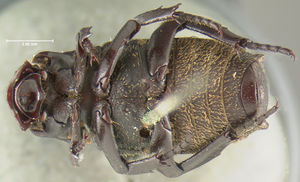Cremastocheilus wheeleri
| Cremastocheilus wheeleri | |
|---|---|

| |
| Scientific classification | |
| Kingdom: | Animalia |
| Phylum: | Arthropoda |
| Class: | Insecta |
| Order: | Coleoptera |
| Family: | Scarabaeidae |
| Subfamily: | Cetoniinae |
| Tribe: | Cremastocheilini |
| Genus: | Cremastocheilus |
| Subgenus: | Cremastocheilus |
| Species: | C. wheeleri |
| Binomial name | |
| Cremastocheilus wheeleri LeConte, 1876 | |
One of about thirty-five species of myrmecophilous Cremastocheilus. The host ant is normally a species in the genus Formica.
Identification
Distribution
Colorado, Montana, Nebraska, Wisconsin; Canada
Habitat
Common host is Formica obscuripes.
Biology
Nomenclature
Description
- Third Instar Larva
Maximum width of head capsule (Fig. 7) 3.0 mm; surface of head roughened, cranium testaceous. Clypeo-frontal suture bounded later ally by precoilae. Frontal suture sinuate. Frons on each side with 1 anterior seta, 1 posterior seta, and 1 anterior angle seta. Dorsoepi cranial setae consist of a dorsal patch of 1 long and 3 short setae and 2 widely separated lateral setae on each side. Labium trilobed; clithra present. Epipharynx (Fig. 8) lacking plegmata; haptomeral region with a curved zygum and a transverse, curved row of spine-like setae; sense cone present at base of epipharynx. Left mandible (Fig. 9) with 4 scissorial teeth; right mandible (Fig. 10) with 3 scissorial teeth. Maxilla with galea and lacinia fused forming a mala; lacinia with 2 terminal unci fused at base, dorsal uncus larger; galea with single terminal uncus. Last segment of antenna with 3-4 dorsal sensory spots. Spiracles reniform. Thoracic spiracle with posterior emargination in respiratory plate; each abdominal spiracle with anterior emargination in respiratory plate. Thoracic spiracle 0.30-0.40 mm long and 0.20-0.25 mm wide. Abdominal spiracles 1-3 similar in size to thoracic spiracle, spiracles 4-7 slightly larger, spiracle 8 smaller than thoracic spiracle. Dorsum of abdominal segment 7 divided into 2 annulets, each annulet with a transverse band of short setae near mid-length and a posterior, transverse row of sparse, long setae. Dorsum of abdominal segment 8 with 2 vaguely divided transverse areas of short setae and 2 widely separated, transverse rows of sparse, long setae. Dorsa of abdominal segments 9-10 fused. Raster without pallidia. Teges with 25-35 short setae surrounded laterally and anteriorly with numerous long, slender setae. Barbulae long, dense. Lower anal lip with several short setae as on teges; anal opening surrounded by dense fringe of long, slender setae. Claws on legs falcate, acute, lacking setae.
- Pupa
Length 12.2-13.7 mm. Shape elongate-ovate, exarate. Color cream white to testaceous. Head glabrous, bent downwards. Antennae, palpi, and greatly expanded clypeus easily discernible; eyes hidden beneath antennae. Pronotum glabrous, subquadrate, widest just before base; disc divided into thirds by 2 longitudinal depressions; exterior third more elevated than middle third. Scutellum large, triangular. Elytra closely appressed to body, curving ventrally around abdomen to 4th or 5th segment. Legs glabrous. Femora extend at about 65?-70? from longitudinal axis of body; spines at apex of each tibia distinct; tarsomeres not distinct.
References
- Alpert, Gary D. 1994. A Comparative Study of the Symbiotic Relationship Between Beetles of the Genus Cremastocheilus (Coleoptera: Scarabaeidae) and their Host Ants (Hymenoptera:Formicidae). Sociobiology 25(1).
- LeConte, J.L. 1876. New species of Coleoptera, collected by expeditions for geographic surveys West of one hundredth meridian &c. Report Chief of Engineers, Washington. 516520.




